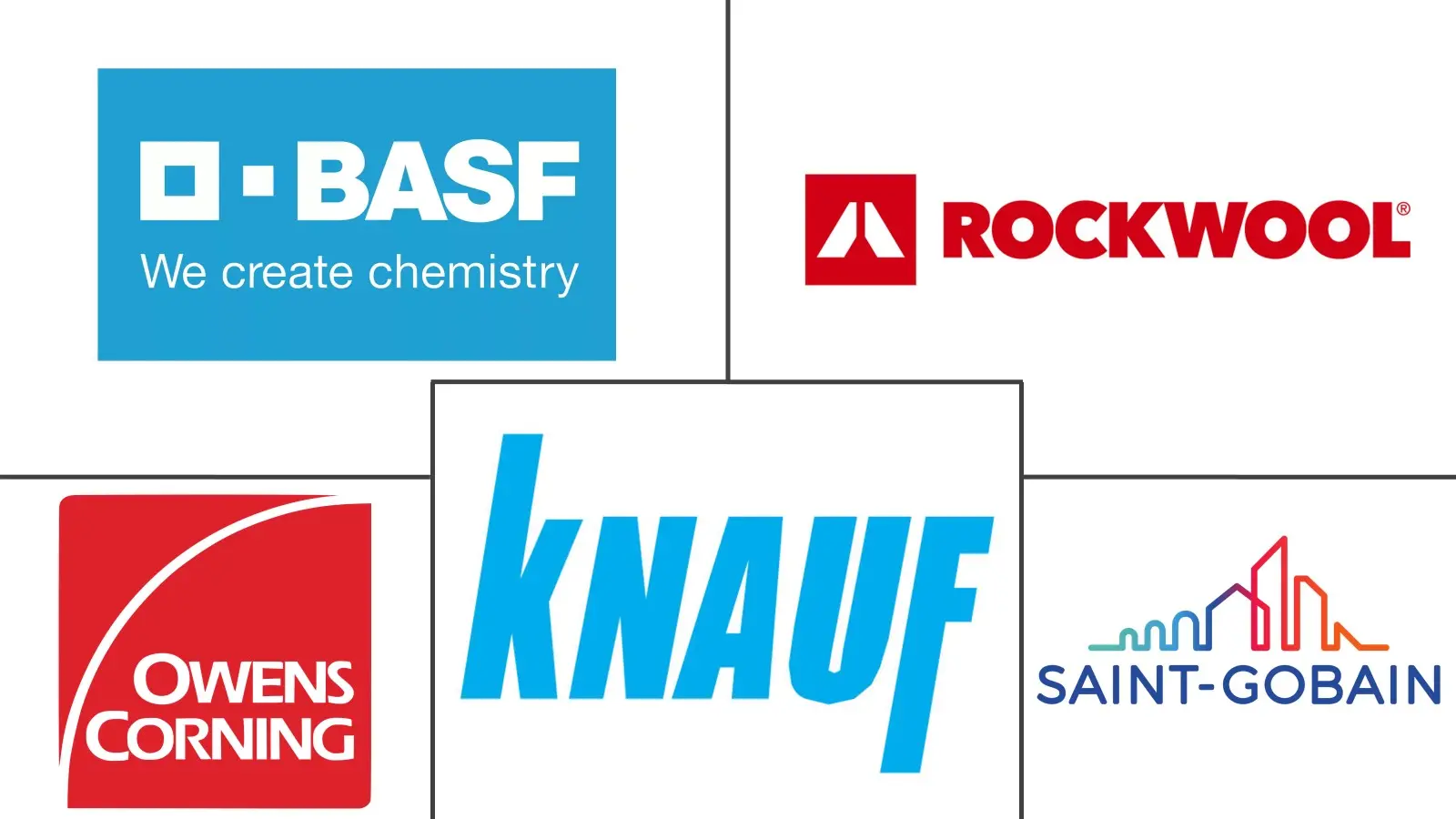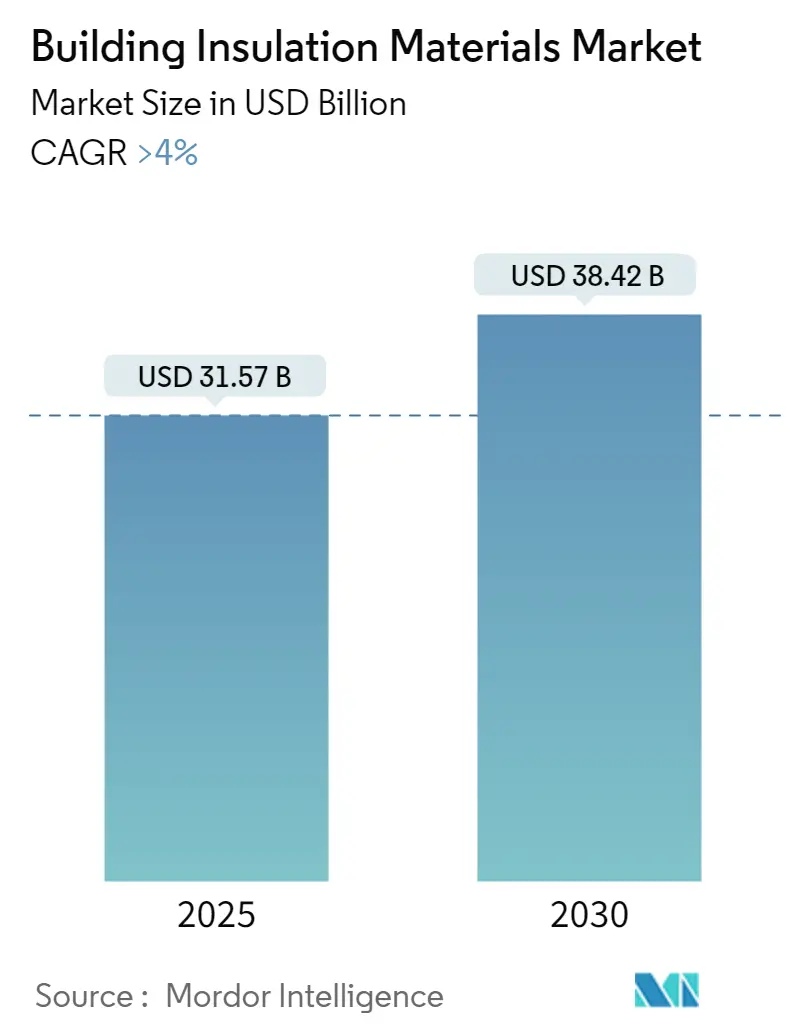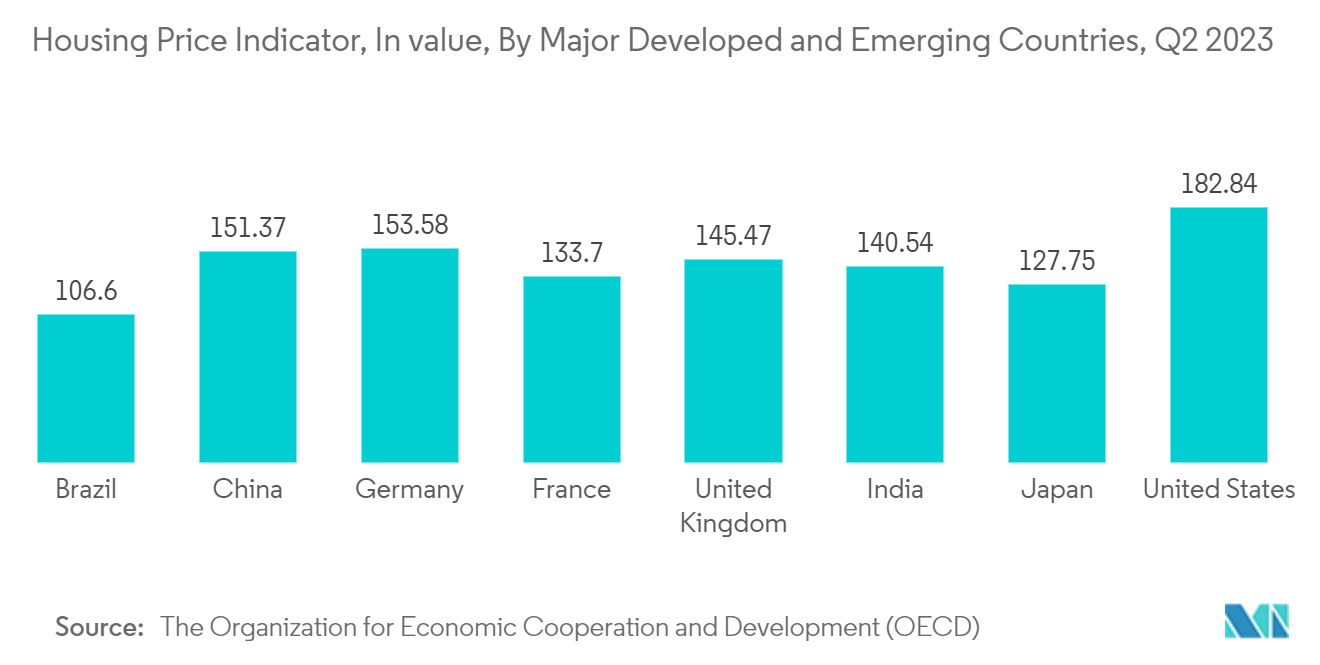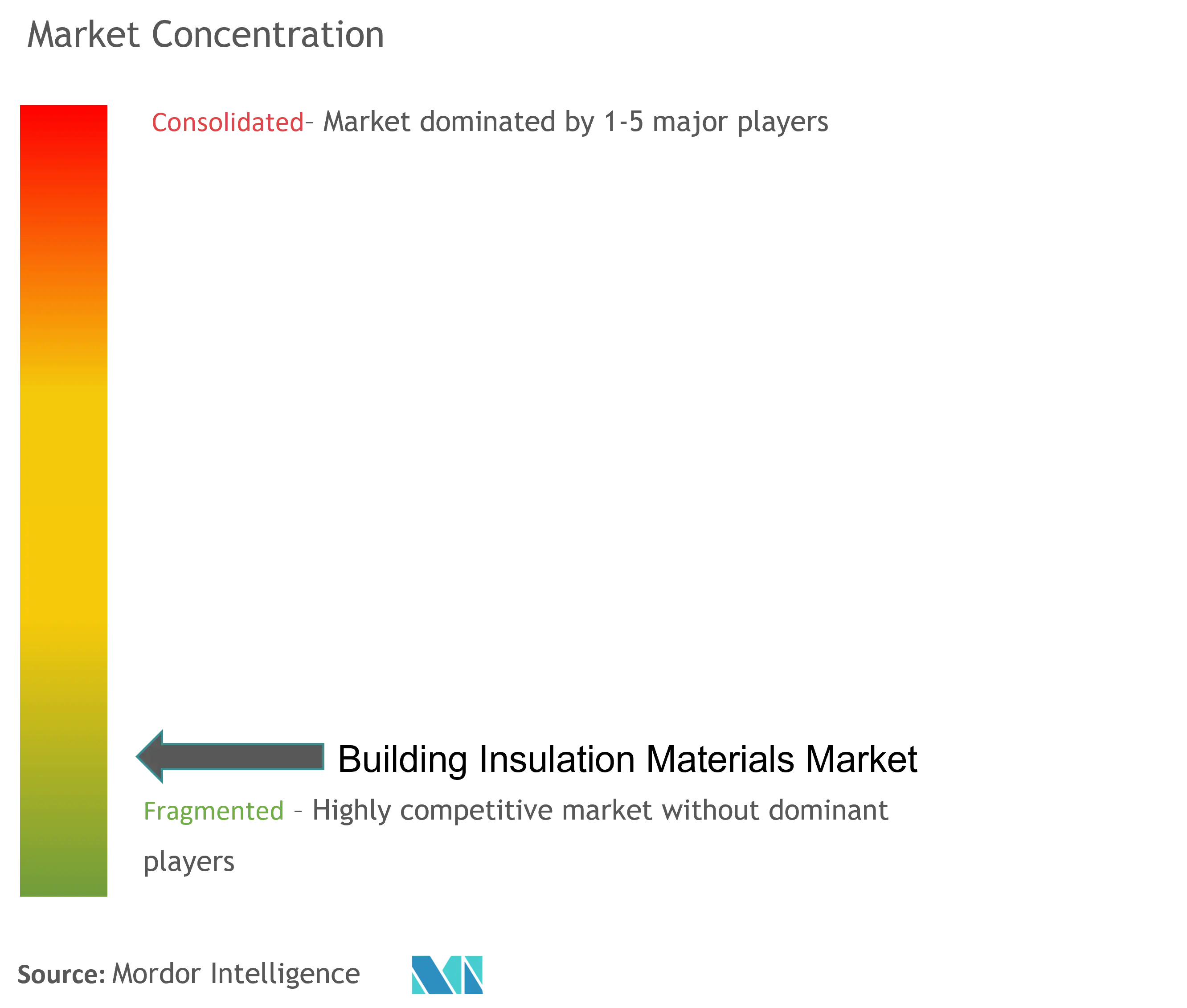Building Insulation Materials Market Analysis
The Building Insulation Materials Market size is estimated at USD 31.57 billion in 2025, and is expected to reach USD 38.42 billion by 2030, at a CAGR of greater than 4% during the forecast period (2025-2030).
Due to the impact of COVID-19 in 2020, the production facilities were halted for several months as lockdowns were implemented, and the supply chains were splintered. However, the market recovered from 2021 to 2022, owing to rising consumption from end-user industries, especially the residential industry.
- The growing demand for energy efficiency, infrastructure expansion, and industrialization in Asia-Pacific are the main factors anticipated to boost the demand for building insulation materials.
- Harmful effects caused by building insulation materials on exposure to high temperatures are expected to hamper the market's growth.
- The use of organic products for insulation may provide new growth opportunities for the market.
- Europe dominated the building insulation materials market. Asia-Pacific is projected to be the fastest-growing market due to the increasing consumption from countries such as China and India.
Building Insulation Materials Market Trends
The Residential Segment to Dominate the Market
- Insulation of residential buildings is gaining popularity due to its architectural and energy-efficiency benefits. Promoting energy efficiency (EE) requirements for new residential buildings has been proven an effective mandatory policy instrument to slow down the increase in energy consumption in the residential building industry.
- Residential construction across the world has witnessed significant growth over the past few years due to population growth, migration from rural areas to service sector clusters, and the growing trend of nuclear families.
- According to the US Census Bureau, the value of private construction in 2023 stood at USD 1,541.0 billion, 4.7% (± 1.2%) higher than the USD 1,472.4 billion in 2022. Residential construction spending in 2023 was USD 864.9 billion, up by 5.8% (±2.1%) from USD 917.9 billion in 2022, while non-residential construction spending accounted for USD 676.0 billion, up by 21.9% (±1.2%) from USD 554.5 billion in 2022.
- The Brazilian government plans to invest BRL 278 billion (~USD 52.19 billion) in popular housing and urbanization works by 2025. This amount will allow contracting up to 2.5 million housing units with very reduced interest rates.
- In recent years, the highest growth rate in residential construction was registered in Asia-Pacific, owing to the expanding housing construction markets in China and India. The housing authorities of Hong Kong launched several measures to accelerate the construction of low-cost housing. The officials aim to provide 301,000 public housing units by 2030.
- According to the Indian government, by 2030, more than 40% of the Indian population is expected to live in urban India, likely creating a demand for 25 million additional affordable housing units.
- As of January 2023, the target to build 26 million houses in the Pradhan Mantri Awas Yojna (PMAY) by 2022 lagged in rural areas as only 21 million houses were built, due to which only 72% of the target was achieved. In urban areas, the target was only achieved by 51%, i.e., out of the 12.5 million houses promised, only 6.12 million were built. In order to ensure the completion of the target, PMAY schemes (for both rural and urban areas) have been pushed till 2024.
- The abovementioned factors are likely to positively affect the demand for building insulation in the residential construction industry during the forecast period.
Europe to Dominate the Market Studied
- Insulation enables the maintenance of the desired temperature in buildings, protecting them against cold in winter and excess heat in summer. A well-insulated house is quite energy efficient and also reduces environmental emissions.
- Europe is undergoing a building renovation wave because the European Commission aims to improve energy efficiency, boost the economy, and deliver better living standards for Europeans. The renovation wave aims to renovate both public and private buildings and at least double the annual energy renovation rate by 2030, in addition to reducing emissions and creating green jobs in the construction industry.
- According to the FIEC (European Construction Industry Federation) Statistical Report 2023, investment in new housebuilding in 2023 was projected to decrease by 3.2%, with the largest drop expected in Sweden (-42.4%). Moreover, in 2022, investment in renovation was most significant in Italy, with an increase of 22% over the previous year.
- This renovation wave will substantially increase the demand for building insulation materials across European countries during the forecast period.
- Germany has the largest construction industry in Europe. Its economy is the largest in Europe and among the top five in the world. The country also has the largest housing stock among European countries, which indicates its dominance over the demand for building insulation materials.
- In Italy, the market for modular construction is expected to increase significantly during the forecast period, with an increase in residential construction activities and various institutional projects. According to Eurostat (a directorate-general of the European Commission), construction revenue in Italy is anticipated to reach around USD 57.68 billion by the year 2025.
- The Global Gateway is a project planned by the European Union to develop new infrastructures. The European Commission said the European Fund for Sustainable Development will make up to EUR 135 billion (~USD 143.84 billion) available for investments in infrastructure projects between 2021 and 2027.
- Overall, the demand for building insulation materials in Europe is expected to grow, benefiting the market studied.
Building Insulation Materials Industry Overview
The building insulation materials market is fragmented, with no player occupying a significant position. The major companies in the market studied (in no particular order) include Saint-Gobain, Owens Corning, Knauf Gips KG, Rockwool International A/S, and BASF SE.
Building Insulation Materials Market Leaders
-
Saint-Gobain
-
Owens Corning
-
Knauf Gips KG
-
Rockwool International A/S
-
BASF SE
- *Disclaimer: Major Players sorted in no particular order
Building Insulation Materials Market News
- November 2023: Kingspan Group launched the HemKor range, under which the company offered its first bio-based insulation product. The product was largely made of hemp to enable it to drive down the embodied carbon of buildings.
- March 2023: Energystore Limited launched its low-carbon footprint insulation product range, Energystore+, which was based on expandable polystyrene (EPS) granules called Neopor BMB from BASF SE.
- February 2023: Atlas Roofing Corporation announced the introduction of EnergyShield XR, a new polyiso insulation product engineered to provide continuous insulation for foundation walls and under slab use.
Building Insulation Materials Industry Segmentation
Building insulation materials are the building materials that reduce heat transfer and form a thermal envelope for the building. Building insulation materials contribute significantly to reducing energy consumption in buildings and sustain the affordability of the construction industry by improving the cost of energy and performance in the building envelope (walls, roofs, floors, etc.), windows, mechanical systems, as well as on-site renewable generation and thermal systems. Building insulation is a material that prevents heat or sound from being transmitted from one area to another. Building insulation is mainly for thermal and acoustic purposes. However, it is also used for impact resistance and fire insulation.
The building insulation materials market is segmented by type, end-user industry, and geography. The market is segmented by types into fiberglass, mineral wool, cellulose, polyurethane/ polyisocyanurate (PUR/PIR) foam, polystyrene, and other insulation materials (hemp, straw, etc.). By end-user industry, the market is segmented into residential and non-residential. The report also covers the market sizes and forecasts for the building insulation materials market in 27 countries across major regions. For each segment, the market sizing and forecasts are provided in terms of revenue (USD).
| Type | Fiberglass | ||
| Mineral Wool | |||
| Cellulose | |||
| Polyurethane/ Polyisocyanurate (PUR/PIR) Foam | |||
| Polystyrene | |||
| Other Insulation Materials | |||
| End-user Industry | Residential | ||
| Non-residential | Commercial | ||
| Infrastructure | |||
| Other Non-residential Industries (Civic, Religious Buildings, etc.) | |||
| Geography | Asia-Pacific | China | |
| India | |||
| Japan | |||
| South Korea | |||
| Thailand | |||
| Indonesia | |||
| Vietnam | |||
| Malaysia | |||
| Rest of Asia-Pacific | |||
| North America | United States | ||
| Canada | |||
| Mexico | |||
| Europe | Germany | ||
| United Kingdom | |||
| Italy | |||
| France | |||
| Spain | |||
| Russia | |||
| NORDIC | |||
| Turkey | |||
| Rest of Europe | |||
| South America | Brazil | ||
| Argentina | |||
| Colombia | |||
| Rest of South America | |||
| Middle East and Africa | Saudi Arabia | ||
| South Africa | |||
| Qatar | |||
| Egypt | |||
| United Arab Emirates | |||
| Nigeria | |||
| Rest of Middle East and Africa | |||
Building Insulation Materials Market Research FAQs
How big is the Building Insulation Materials Market?
The Building Insulation Materials Market size is expected to reach USD 31.57 billion in 2025 and grow at a CAGR of greater than 4% to reach USD 38.42 billion by 2030.
What is the current Building Insulation Materials Market size?
In 2025, the Building Insulation Materials Market size is expected to reach USD 31.57 billion.
Who are the key players in Building Insulation Materials Market?
Saint-Gobain, Owens Corning, Knauf Gips KG, Rockwool International A/S and BASF SE are the major companies operating in the Building Insulation Materials Market.
Which is the fastest growing region in Building Insulation Materials Market?
Asia Pacific is estimated to grow at the highest CAGR over the forecast period (2025-2030).
Which region has the biggest share in Building Insulation Materials Market?
In 2025, the Europe accounts for the largest market share in Building Insulation Materials Market.
What years does this Building Insulation Materials Market cover, and what was the market size in 2024?
In 2024, the Building Insulation Materials Market size was estimated at USD 30.31 billion. The report covers the Building Insulation Materials Market historical market size for years: 2019, 2020, 2021, 2022, 2023 and 2024. The report also forecasts the Building Insulation Materials Market size for years: 2025, 2026, 2027, 2028, 2029 and 2030.
Our Best Selling Reports
Building Insulation Materials Industry Report
Statistics for the 2025 Building Insulation Materials market share, size and revenue growth rate, created by Mordor Intelligence™ Industry Reports. Building Insulation Materials analysis includes a market forecast outlook for 2025 to 2030 and historical overview. Get a sample of this industry analysis as a free report PDF download.







